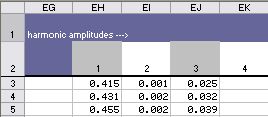Each row on the EFAResults worksheet (shown below in 3 panels) refers to a single valve outline.

Column A (yellowed)
is used only to select valve (specimen) outlines
to be reproduced from the elliptical Fourier coefficients.
Columns B through
K contain descriptive, identification and processing information about
each valve.
Sampling (column F) refers to the number of points in the smoothed-and-sampled
outline subjected to EFA.
Length (column H) is based on the difference in the maximum and
minimum x-coordinate values of rotation-standardized specimens.
Area (column I) is calculating using Eves'
(1972) method
for two-dimensional polygons.

Column L refers to
the number of harmonics extracted in the EFA.
Columns M to ED (potentially) contain the elliptical Fourier coefficients
which describe the valve; data for 3 harmonics are shown in the above
panel from the worksheet. All coefficients are in sets of 4 (a, b, c,
d), except those of the zeroth harmonic, a(0) and c(0), which indicate
the x- and y-coordinates, respectively, of the outline centroid. If the
outline has been size-normalized using the Rohlf-Archie
option in the Invariance (EFA) frame, then coefficient a(1) will be
1.0, coefficients b(1) and c(1) will be zero, and the value of coefficient
d(1) will indicate the ellipticity of this first harmonic ellipse.

Harmonic amplitudes are listed for each harmonic beginning in column EH; the above panel illustrates only 3 of them for 3 valves.